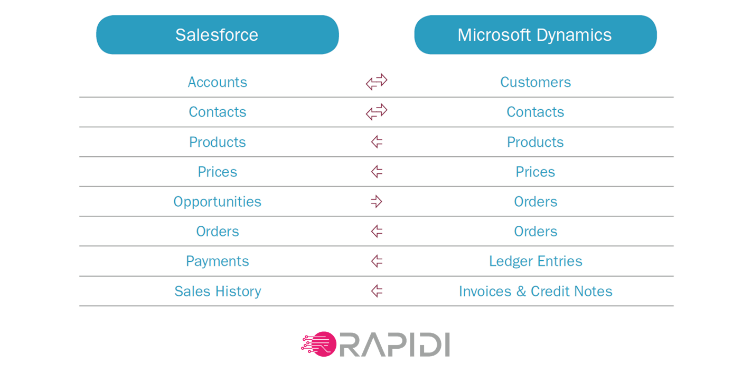It’s no secret – Rapidi specializes in integrating salesforce.com with Microsoft Dynamics. I have included in this article a graphical representation of what a “typical” case looks like. However, your integration does not have to work the same way. Your data integration solution should be functionally rich enough to handle even very complex cases in a very simple way. With a solution like RapidiOnline, for example, you can freely decide which tables and fields you want to integrate, whether the integration should be bi-directional or just one direction, as well as how often you want your data to synchronize. We can easily take case of this for you, giving you the freedom to concentrate on what really matters to you and what will make the difference for your business: what should you integrate? What is a “must integrate”, what is a “nice to have” and what can be kept out of the integration?

Example of a typical integration using RapidiOnline pre-configured tables and fields
Make a confident and informed decision about what you should integrate
To my experience, the most common integration points between a Salesforce.com CRM and Microsoft Dynamics ERP are about accounts / customers, contacts, products/items, orders, opportunities, orders, payments, ledger entries, sales history, invoices and credit notes. Do you need to synchronize all of it? Maybe, maybe not. Here’s some advice to help you decide:
Account-customer
If one of your greatest needs is the integration of salesforce quotes with Microsoft Dynamics sales orders, you will have to make sure that your customers in Salesforce are synchronized with your accounts in Dynamics – simply because an order is always linked to a customer. Have a look at what your needs are – for example, if you want both your sales and financial divisions to be able to maintain your customer information, then you need to implement a bi-directional integration.
Read also: 6 awesome benefits to ERP-CRM integration
Contact-contact
This is one of the most common integrations as contact data is typically master data.
Product-Item
If you want to fully support your quote to sales order process you will need product/item information maintained in both your salesforce.com and Microsoft Dynamics systems.
Item price – Product price
Salesforce.com and Microsoft Dynamics have different pricing and discounting models, but the integration can still be easily done.
Quote – Order
Having to create a sales quote in your Microsoft Dynamics ERP and then in your salesforce.com is not an optimal process. When the quote becomes and order you can convert the quote to a sales order in Microsoft Dynamics but you have then to manually update salesforce.com. It’s a workaround but it is not very flexible and very much error-prone. The integration adds a lot of value at this level.

Read also: Get a step closer to your customers with ERP-CRM integration
Sales order – Sales order
This process is often forgotten when thinking about data integrations. Once the quote is transferred from Salesforce to a sales order in Microsoft Dynamics, the sales order should be synced back to salesforce.com in order to maintain a full picture on the account /opportunity.
Sales history
Sales history is always on the list of integrations because of the value of information. Sales history is captured by transferring booked invoices from Microsoft Dynamics to salesforce.com. To get the full picture you will also need to include credit memos.
Payments
To complete the quote to cash process, we recommend transferring payments as well. It gives additional information that is often hard to get such as payment patterns, overdue amounts etc. directly on a prospect or account in salesforce.com. Besides being valuable information to the sales organization, it can also help your cash collection and be used as a negotiation parameter for new deals with the customer.
Read also: ERP-CRM integration: the key to excellent customer service
Considering these transfers should get you off to a good start. If you have more complex processes or are considering additional transfers to support your business processes, feel free to get in touch with me and have an informal chat about how it can be done. Alternatively, you can read more about ERP-CRM integration in our data integration hanbook below.











